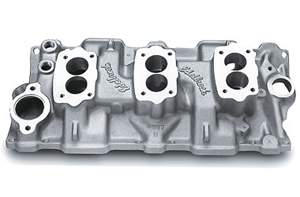Performance intake manifold manufacturers offer several different options to get air and fuel from carb to heads. The secret is choosing the right intake manifold for your specific application using these three easy steps:

Dual-Plane, Single-Plane or Others
Carbureted intake manifolds come in a variety of styles: dual-plane, single-plane, air-gap, tunnel ram and others. Choosing the right design basically comes down to matching the intake style to your customer’s vehicle and intended rpm operating range.
Dual-plane intake manifolds, also sometimes called 180-degree intake manifolds, have two separate plenums that accept air/fuel from the carburetor. Each one of the plenums, or openings, feed four cylinders on a V8 engine. This divided design ensures that each bank of four cylinders only sees every other firing pulse (or 180 degrees of crank rotation), so there’s less overlap between induction pulses. The result is a cleaner induction pulse, particularly at low rpm. Dual-plane intake manifolds also typically have longer intake runners, making them ideal for low and midrange power production. Choose a dual-plane manifold for:
• Low-rpm response and power in the 1,500-6,500 rpm range;
• Good idle quality; and
• Street performance and mild racing.
Single-plane intake manifolds use a single open plenum, which feeds all eight cylinders on a V8 engine. Although this design doesn’t provide the dual-plane’s clean induction pulse in the low-rpm range, it generally allows for better, more equal flow distribution between cylinders. In addition, single-plane intakes typically have shorter, more-direct runners, so they’re able to move higher amounts of air from the carb to the heads. That makes single-plane intakes perfect for:
• High-rpm horsepower through 8,000 rpm; and
• Racing applications.
While dual-plane and single-plane intake manifolds are the most common intake styles, there are a few additional options available. Air-Gap intake manifolds, such as the Edelbrock Air-Gap Performer RPM, improve on the typical dual-plane design by raising the intake runners. By adding extra space between the bottom of the intake and the engine, the runners are kept cooler and the intake charge remains colder and denser. Choose an Air-Gap-style intake for:
• Enhanced power from idle-5,500 rpm; and
• Street performance.
Tunnel ram intakes are dual-carb intakes that became popular on dragstrips in the 1960s and 70s. These distinctively tall single-plane intakes utilize longer runners than typical single-plane manifolds, effectively expanding the rpm powerband. Keep in mind, the dual-carb design calls for additional tuning, and the dimensions of the intake require more space. Choose a tunnel ram intake for:
• High-rpm power;
• Racing and wild street applications; and
• Aggressive look.
Depending on your application, you can also find a wide range of dual-quad and tri-power intake manifolds for multi-carb setups. Like single-carb manifolds, these intakes are available in dual-plane, single-plane, and even Air-Gap designs.
Find the Right Fit
Once you’ve selected the right intake manifold style for your application, you need to choose a manifold that fits your engine. Whether you’re shopping for a carbureted or fuel-injection intake manifold, consider the following factors:
• Hood clearance;
• Cylinder head port design; and
• Carburetor/throttle body mounting.
For street applications, hood clearance is a major consideration. If your customer wants to retain the use of his hood, measure the height of the stock manifold and try to remain close to that dimension when choosing a performance intake manifold. Your customer can accommodate higher intake manifolds by using a hood scoop, low-profile air cleaner assembly, or other means. But remember, this will result in added time and cost.
Cylinder head port design is also an important consideration. For example, big block Chevy heads are available with multiple ports designs, including rectangular, oval, and peanut-style. Always make sure the intake runner ports match up with the intake ports on your cylinder heads.
On the top end, you need to make sure your new intake manifold will work with the carburetor’s mounting pad configuration. Four-barrel carbs, for example, are available with three basic mounting pads: square bore, spread bore, and Dominator style. Check to see what type of mounting pad your carburetor uses and then make sure the intake matches up with it. If you’re buying a fuel-injected manifold, make sure the throttle body inlet works with the throttle body size.
Fine Tune The Choice
Once you and your customer have settled on a general intake style, confirmed the proper port style, and verified the carb mounting pattern, you may decide to look at all the little details that separate each intake manifold. If you live in an area that employs special emissions regulations (i.e., California), look for a CARB E.O.-certified intake manifold. You can also compare port cross-section, plenum volume, and specific runner lengths to really narrow down your choice.
What’s the right way to get from point A to point B? When it comes to getting air/fuel from your carburetor to your cylinder heads, there are a lot of options.
– Tech Tip courtesy of Summit Racing.













